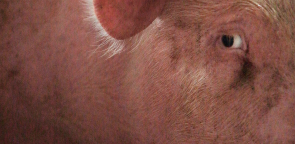
Every year only one-third of the patients on transplant waiting lists get an organ. Thanks to major genetic advances, pigs could soon supply organs for human recipients.
ŌĆ£Waiting lists are growing relentlessly, while the number of organ donors remains inadequate,ŌĆØ says Manuel Pascual, chief physician at the Centre for Organ Transplantation at the Lausanne University Hospital (CHUV). After its release in the 1980s, the immunosuppressant ciclosporin was used to perform the first human-to-human organ transplants and suppress acute immune responses. L├®o B├╝hler, medical director with the Visceral and Transplantation Surgery Service at Geneva University Hospitals (HUG), believes that this drug was a revolution and is the reason why we now have a shortage of organs. To solve that problem, doctors could one day be able to prescribe pig organs for their patients. ŌĆ£These animals offer an unlimited source of organs that are immediately available, and we could begin treating the disease much earlier.ŌĆØ
Xenotransplantation is back on the table
Xenotransplants, meaning any transplantation of animal organs into humans, are not a new idea. Back in 1906, the French surgeon Mathieu Jaboulay performed the first transplants using goat and pig kidneys into humans. These attempts resulted in failure due to the rapid rejection by
the recipientŌĆÖs immune system. Despite the progress in immunology and technology over the past 110 years, xenotransplants are still rejected by the human body. But recent progress in genetic engineering, more specifically the development of CRISPR-Cas9 technology, could offer new options.
CRISPR-Cas9 is a new technique that works like a pair of precision molecular scissors used to cut up DNA. This system makes it relatively easy to modify gene sequences. Nicole D├®glon, director of the Neuroscience Research Centre at CHUV, explains that the previous systems using proteins to recognise a DNA sequence were too complex and unreliable. CRISPR is based on RNA, which is reliable and easy to synthesise. The protein Cas9 simply cleaves DNA and is universal.
Despite the progress in immunology and technology over the past 110 years, xenotransplants are still rejected by the human body.
Apes are even closer genetically to humans and have organs that are compatible in terms of size and function. This, in theory, makes them good candidates to be donors. But there are significant disadvantages to using apes, mainly in terms of reproduction. ŌĆ£Pigs reach sexual maturity when they are seven months old, but it takes baboons ten years,ŌĆØ L├®o B├╝hler says. ŌĆ£And they only carry one individual at a time. ItŌĆÖs not enough.ŌĆØ Furthermore, Swiss legislation bans the use of primates as an animal resource and, for ethical reasons, sacrificing apes and monkeys is less acceptable due to the behavioural similarity with humans,ŌĆØ Manuel Pascual says.
What about monkeys?
The bonus is that the technology can be applied in vivo and accelerates the production of genetically modified organisms in unprecedented ways. Manuel Pascual believes that this advance could spark renewed interest in xenotransplantation research by speeding up the humanisation of pigs. ŌĆ£Ten years ago, no one would have predicted a future for organ xenotransplantation, but discussions of potential clinical applications could pick up again.ŌĆØ
Why pigs?
The best candidates for cross-species transplantation
are pigs, due to their similarity to humans. ŌĆ£We share nearly 99% of the same DNA, and our organs are close in size and function in virtually the same way,ŌĆØ says Alexandre Reymond, geneticist and director of the Center for Integrative Genomics (CIG) at the University of Lausanne. ŌĆ£Despite this similarity, these animals are genetically distant enough from humans to limit the transmission of animal viruses.ŌĆØ Another advantage is that sows carry up to ten piglets every three months, B├╝hler says. This rapid reproduction is ideal for manipulating genes (see inset), because, compared with other species, the frequency and number of births make it easier to cross-breed and select individuals that carry or do not carry modified genes. The probability of getting a genetically modified individual is higher in the case of multiple births.
Small genetic differences between pigs and humans also explain the severe rejection of pig transplants. One of the causes is alpha-gal. This sugar is not found in humans, and transgenic animals without alpha-gal have been created. However, it ŌĆ£was a huge disappointment, because organ rejection continued,ŌĆØ Pascual says. Today, cross-species organ transplants have still only been tested in primates and, for the time being, have not produced results that are encouraging enough to take forward into clinical trials. CRISPR-Cas9 could stimulate research by making it easier to genetically modify pigs, as pig genes could be deleted and replaced with human genes.
Another major problem is that pigs carry retroviral vectors
that are potentially harmful for humans. ŌĆ£These are viruses that modify the DNA of their host,ŌĆØ Reymond says. Again, animals should be genetically modified to suppress any traces of retroviruses. That is in part what the Harvard University geneticist George Church achieved in in vitro cell lines (ŌĆ£ScienceŌĆØ, 2015) using CRISPR-Cas9 technology, showing the full potential of this new technique in xenotransplantation.
No ethical or legal impediments
The idea may sound shocking, but the ethical and legal obstacles could be overcome. In Switzerland, federal law on organ transplants governs xenotransplantation, requiring authorisation from the Swiss Federal Office of Public Health (FOPH). L├®o B├╝hler states that there are no religious barriers, as the worldŌĆÖs three major religions have approved the concept of xenotransplantation to treat people. It is only eating pork that is forbidden for Jews
and Muslims.
So one day, we might hear, ŌĆ£Pork kidneys for 12,ŌĆØ not at a restaurant, but at a hospital! Ōüä